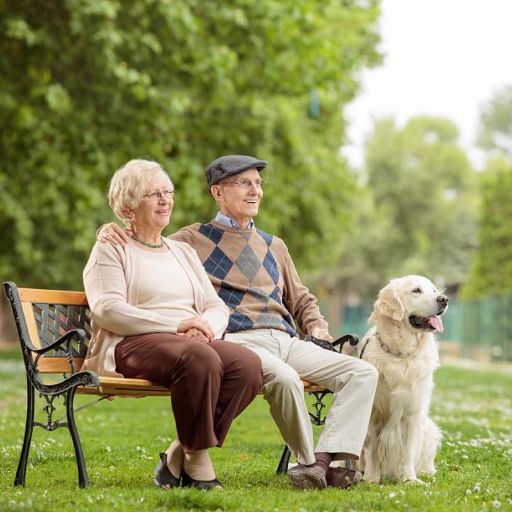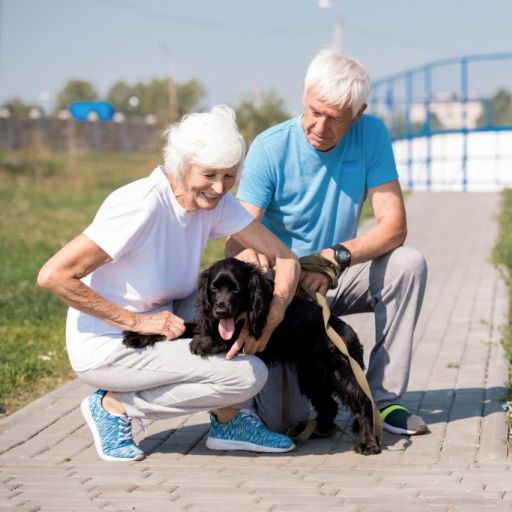Advertisement
In a busy life, work, family, and social responsibilities occupy most of the time. When they reach retirement age, the elderly finally have their own relatively free time.
But at the same time, as they age, their physical fitness declines, and health problems begin to emerge, and many elderly people feel lonely and bored.
For many elderly people, the company of their dogs has become a highlight in their lives, which not only brings emotional satisfaction, but also becomes an important way to maintain health and vitality. For example, when walking their dogs, the elderly can feel the joy of companionship through interaction with their dogs.
Every morning, the elderly gently hold the dog leash, walk steadily, and leisurely walk with their dogs in the park. The dog is full of energy, running and stopping at the feet of the owner, and occasionally sticking his head out to smell the flowers and plants on the roadside, or chasing the birds on the trees.
Occasionally, the elderly and their dogs play a ball-throwing game. The dog runs excitedly, quickly picks up the thrown ball, and wags its tail to look at the owner flatteringly.
At this moment, the interaction between people and dogs is full of tacit understanding and joy, and the elderly smile is full of satisfaction. Dog walking is not only a physical exercise, but also a spiritual enjoyment.
In the time spent with their dogs, the elderly forget their age and regain the ease and pleasure of life. The daily dog walking time has become the simplest but happiest exercise in their lives. Whether it is physical exercise or spiritual comfort, dog walking has brought irreplaceable benefits to the elderly. Dogs accompany you and you are healthy.

Dog walking - the "golden key" to the health of the elderly
Dog walking seems simple, but this activity has an important positive effect on the health of the elderly. The process of dog walking includes daily walking, interaction with dogs, outdoor activities and other forms.
It combines the benefits of physical, psychological and social aspects and has become an important part of the elderly to maintain health.
1. Enhance physical strength and cardiopulmonary function
With the increase of age, the metabolism of the elderly gradually slows down, and the cardiopulmonary function and muscle strength also decline. Long-term lack of exercise will aggravate this degeneration.
Dog walking provides an easy and continuous exercise opportunity for the elderly. Walking the dog regularly every day can not only help the elderly maintain a certain amount of activity, but also allow the elderly to breathe fresh air outdoors while doing low-intensity exercise to promote blood circulation and enhance cardiopulmonary function.
Walking the dog does not require strenuous exercise, but the health benefits of each short walk accumulated should not be underestimated. Studies have shown that walking 30 minutes a day for the elderly can help reduce the risk of heart disease, stroke, etc.
The daily activity of walking the dog can easily achieve such a large amount of exercise, which not only allows the elderly to gradually restore their physical strength, but also helps control weight and reduce the risk of obesity.
2. Prevent chronic diseases and enhance immunity
The process of walking the dog can effectively promote the metabolism of the elderly and help prevent the occurrence of various chronic diseases.
Common geriatric diseases such as hypertension, diabetes, osteoporosis, etc. are closely related to long-term lack of exercise. Moderate exercise when walking the dog can help regulate blood sugar levels, lower blood pressure, and strengthen bones and muscles.
In addition, when walking the dog, the elderly will be exposed to sunlight, and the vitamin D in the sunlight helps to strengthen the immune system and prevent osteoporosis and joint diseases.
For the elderly who seldom go out in their daily lives, dog walking provides them with a natural outdoor activity opportunity, allowing them to be more exposed to sunlight and fresh air, thereby enhancing immunity and improving physical resistance.

3. Improve mental health and reduce loneliness
After retirement, many elderly people will face the problem of loneliness and depression, especially when relatives and friends are not around, this loneliness may be aggravated.
The company of dogs plays an important role at this time and becomes a "companion" in the lives of the elderly. Studies have found that pets, especially dogs, can help the elderly reduce anxiety, stress and loneliness and improve their mental health.
Going out for a walk with their dogs every day, the elderly can not only enjoy the company of their dogs, but also meet other dog owners during the dog walk. Such social interaction helps the elderly establish new social circles, relieve loneliness and increase the fun of life.
The innocent and lively personality and interaction of dogs can often bring people laughter and happiness, and improve overall life satisfaction.
4. Promote good sleep
The elderly often face sleep problems, such as insomnia and shallow sleep. Exercise is an important factor in improving sleep quality. Dog walking can help the elderly consume physical energy and relax their body and mind through moderate exercise during the day, so that they can fall asleep more easily at night.
In addition, contact with nature during dog walking can also help regulate the biological clock, promote the secretion of melatonin in the body, and help the elderly fall asleep better and maintain deep sleep.
Therefore, regular dog walking is not only good for physical health, but also improves the quality of sleep of the elderly, helping them have more energy to enjoy life.

5. Improve cognitive function and memory
As they age, many elderly people begin to face the problem of declining cognitive function and memory loss. Studies have shown that exercise has a significant effect on improving cognitive function and memory.
Advertisement
Dog walking, a daily activity, can not only exercise the body, but also stimulate the brain activity of the elderly through interaction with their dogs and changes in the environment, and delay the decline of cognitive ability.
During dog walking, the elderly need to pay attention to the movements and behaviors of their dogs and stay alert to the surrounding environment.
This continuous mental activity helps to keep the brain active and prevent the rapid decline of cognitive ability. In addition, interaction and communication with others can also help the elderly maintain brain flexibility, thereby improving overall cognitive health.
6. Cultivate a sense of responsibility and daily routine
Owning a dog is not only a kind of companionship, but also a responsibility. Dogs need to go out for a walk, feed and take care of every day, which makes the lives of the elderly regular. Day after day of dog walking helps the elderly develop a fixed schedule and effectively avoid laziness and idleness in daily life.
A regular daily life is an important factor in maintaining physical and mental health. Dog walking as a daily activity not only helps the elderly increase small goals in life, but also enhances their sense of responsibility and self-discipline.
Walking with your dog every morning or evening has become a habit. This positive attitude towards life also helps the elderly maintain a balanced and happy mentality.
7. Cultivate a connection with nature and improve happiness
When walking the dog, the elderly can go out of the house and get in touch with nature. The beauty and tranquility of nature can help reduce stress and anxiety and improve happiness.
In the process of walking the dog, the elderly can feel the breeze, birdsong, and the fragrance of flowers. This interaction with nature is not only beneficial to the body and mind, but also helps them stay in a good mood and reduce negative emotions.
Walking with their dogs in parks, paths or fields, the elderly can get away from the trivialities of daily life and enjoy a moment of peace. Such natural experiences can help them find the balance in life again and enhance their sense of happiness and satisfaction in life.
8. Social bridge, expand the social circle of the elderly
Walking the dog is not only a physical exercise, but also a social bridge. Many elderly people have made new friends through dog walking.
Interaction and communication between dog owners are very natural. During dog walking, they often meet other people with dogs. Such accidental encounters can often stimulate conversations and form new social relationships.
For those elderly people whose social circles are gradually shrinking, dog walking provides them with an opportunity to socialize easily.
While walking the dog, the elderly can share their dog-raising experience, exchange life stories, and even establish deep friendships with other dog owners. Through these social interactions, the elderly can more actively integrate into the community and increase the diversity and fun of life.
9. Establish a deep emotional connection with dogs
Dogs are not only the companions of the elderly, but also their "family". In the day-to-day companionship, the elderly and dogs have established a deep emotional connection.
The loyalty and unconditional love of dogs make the elderly feel endless warmth and comfort. This emotional connection not only helps the mental health of the elderly, but also enhances their happiness and satisfaction.
Studies have shown that pets can reduce the incidence of anxiety and depression. For elderly people living alone, dogs are an important emotional support in their lives.
The time spent with their dogs every day is not only physical companionship, but also a kind of spiritual comfort, allowing the elderly to feel the warmth and love of life.

10. Dog walking skills
When walking the dog, throwing balls and chasing games are the most common and fun ways of interaction. The elderly gently throw the ball, and the dog immediately runs excitedly, running on the grass with flexible limbs, and his eyes are full of concentration and joy.
It quickly finds the ball, picks it up with its mouth, and happily returns to the owner with a wag of its tail, waiting for another throw.
This simple game not only allows the dog to release excess energy, but also allows the elderly to keep their bodies active through back and forth movement.
In the chasing game, the dog runs back and forth quickly, and the elderly follow with a smile, enjoying the time of interacting with the dog. This game not only brings people and dogs closer together, but also adds endless joy to dog walking time.
11. Interaction and training with dogs
Training dogs with some basic commands, such as "sit down" and "come here", can significantly improve the obedience of dogs and make the dog walking process smoother and safer.
Through simple training, the elderly can better control the behavior of their dogs when walking their dogs to avoid accidents. For example, the "sit down" command can help dogs calm down when they are excited or nervous, and stop running around or jumping on passers-by.
The "come here" command can call the dog back to the side in time when it walks away or encounters danger, effectively preventing it from getting lost or accidental injury.
These trainings can not only improve the obedience of dogs, but also strengthen the communication and trust between people and dogs.
During the dog walking process, dogs are more willing to follow the owner's command and maintain an appropriate distance and speed, which makes the dog walking activity more pleasant and relaxing. At the same time, training is also a form of interaction.
The elderly and dogs establish a deeper emotional connection during training, making daily walks more interesting, and adding fun and sense of accomplishment to getting along with their dogs while exercising.
Advertisement





